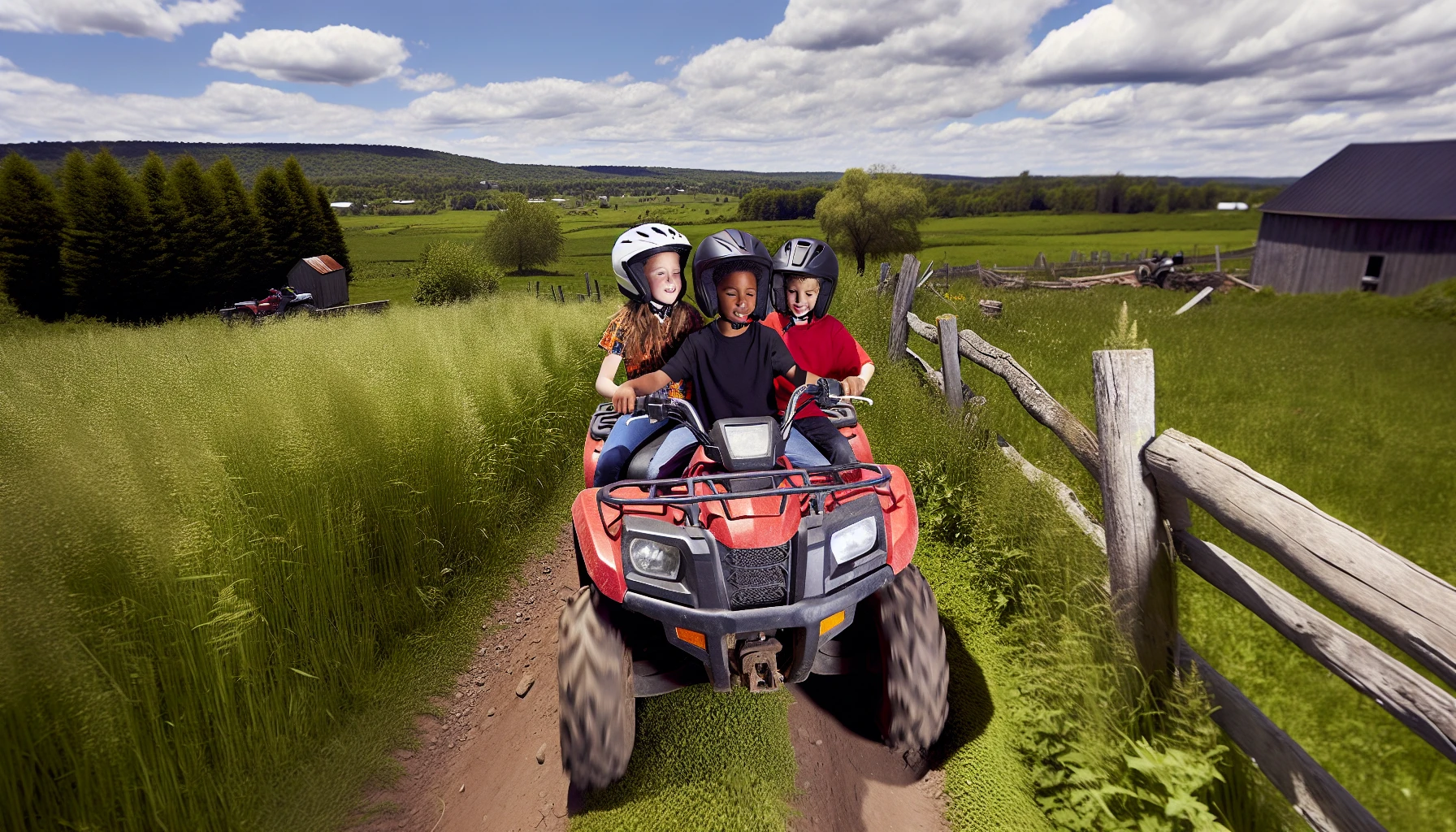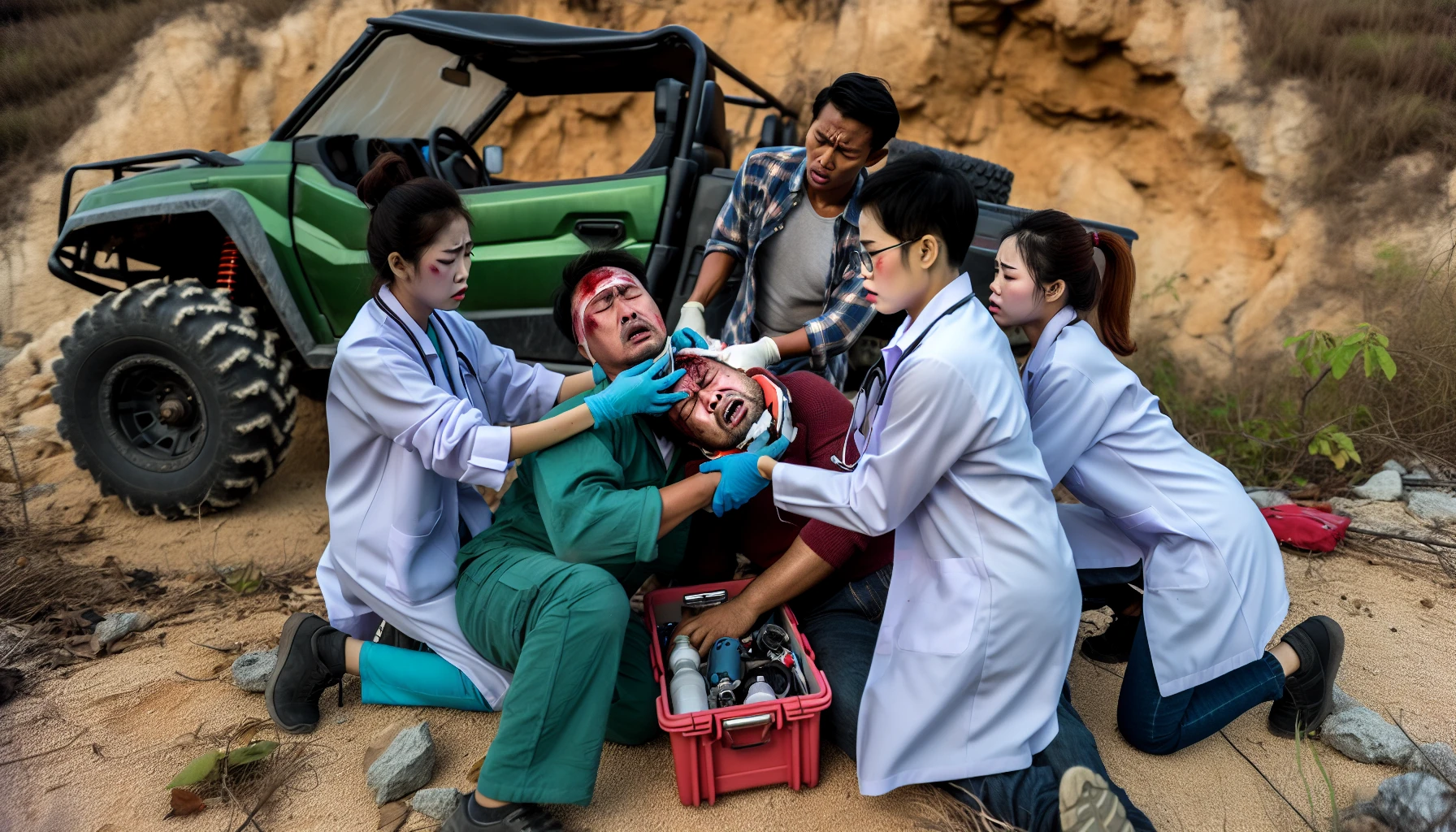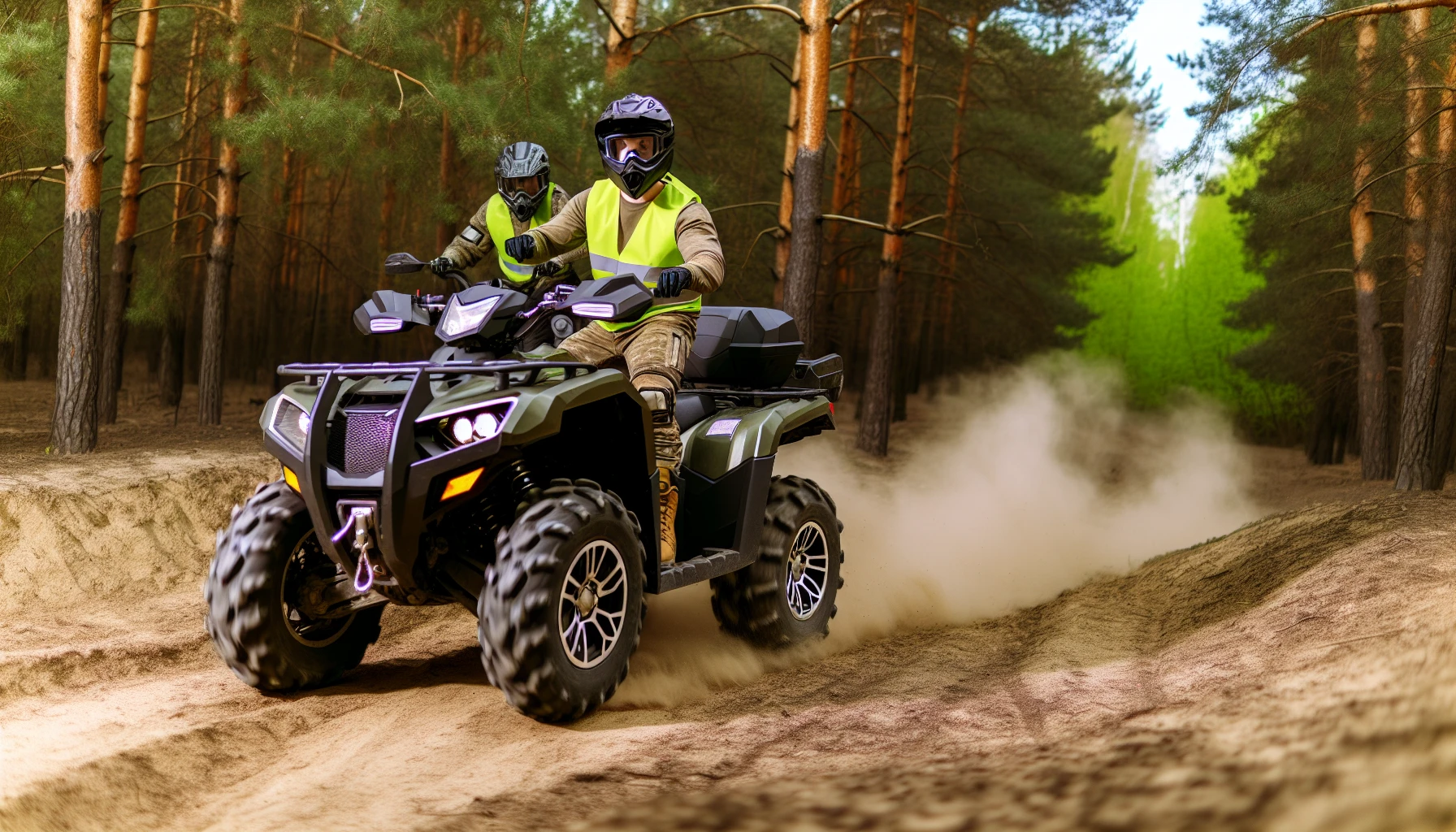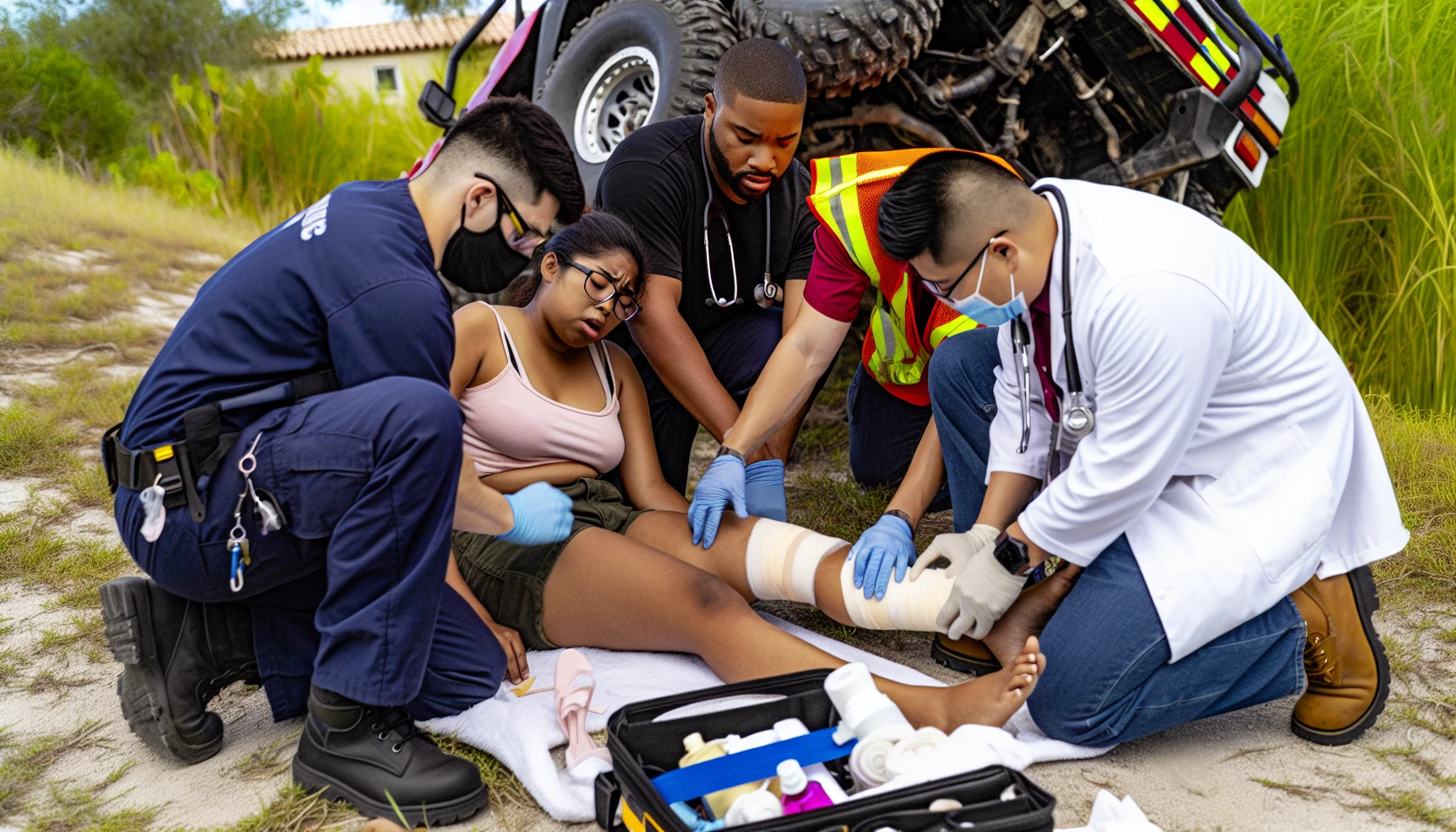All-terrain vehicles (ATVs) have gained popularity for their off-road capabilities and thrilling rides. However, with this excitement comes a significant risk of accidents and injuries. To better understand the dangers and how to minimize them, let’s explore the world of common ATV accident injuries and the precautions that can be taken to prevent them.
Key Takeaways
- ATV accidents are alarmingly common, with hundreds of fatalities and thousands of injuries reported annually.
- Adopting the right safety measures such as wearing protective gear, taking proper training and following responsible riding practices is essential to minimize ATV accident risks.
- After an accident, victims may seek compensation through personal injury claims or product liability cases while medical care plays a pivotal role in aiding recovery process both immediately after the incident and long term rehabilitation.
The Prevalence of ATV Accidents

ATV accidents, including atv related accidents, are alarmingly common, with approximately 300-400 fatalities reported annually and thousands of people sustaining severe injuries. In 2017 alone, over 93,800 emergency room visits were attributed to ATV-related injuries. These accidents can result in life-changing medical issues, such as:
- Traumatic brain injuries
- Spinal cord injuries
- Broken bones
- Internal organ damage
- Severe lacerations
Among these consequences, atv related deaths are a tragic outcome that affects hundreds of families each year.
These injuries often require costly and extensive treatment, including surgeries, rehabilitation, and ongoing medical care. It is crucial to prioritize safety and follow proper ATV riding guidelines to reduce the risk of accidents and injuries.
Notably, children and inexperienced riders are at a higher risk of being involved in ATV accidents. In fact, more than half of the injured victims are children, and the average age of those injured is 21. This highlights the importance of implementing targeted safety measures to protect these vulnerable groups.
Common Causes
Inexperienced ATV drivers are often more prone to ATV accidents compared to those with experience. Providing sufficient instruction and guidance can help prevent accidents and the devastating consequences that may arise, such as head and brain injuries.
Riding techniques that involve dangerous stunts or excessive speed can also heighten the accident rate. Environmental conditions like off-road terrains may pose additional risk for those with less experience.
Age and Gender Factors
Children under 16 and male riders are more likely to be involved in ATV accidents, indicating a need for tailored safety measures. It is not recommended for individuals under the age of 16 to operate adult ATVs, as they may lack the cognitive capacity and fine motor skills necessary to operate them properly.
In fact, 52% of injured victims are children, and 17% are female. This data highlights the importance of implementing age- and gender-specific safety measures to mitigate the risks associated with ATV use.
Types of Injuries Sustained in ATV Accidents

ATV accidents can result in a wide range of injuries, including head and brain injuries, spinal cord injuries, and extremity injuries. These accidents atv injuries can be life-altering, requiring extensive medical care and rehabilitation to recover fully.
The severity of injuries can vary, with some victims experiencing mild symptoms and others suffering from debilitating, long-term consequences. Next, we will examine various injuries that can result from ATV accidents and how they could potentially impact the lives of the victims.
Head and Brain Injuries
Traumatic brain injuries (TBIs) are common in ATV accidents and can range from mild to severe. A traumatic brain injury may present symptoms such as:
- Loss of consciousness
- Headache
- Dizziness
- Nausea
- Confusion
- Memory problems
- Mood changes
These symptoms are often associated with TBIs and require prompt medical attention to prevent further complications.
Physical exams, brain scans and emergency surgery may all be necessary for treating severe cases of TBI. In particular, the removal of blood clots or the repair of fractured skull fragments are common treatments. Additionally, surgery may be necessary to alleviate pressure on the brain. Prompt medical care is necessary for the accurate diagnosis and effective treatment of head and brain injuries that result from ATV accidents.
Spinal Cord Injuries

Spinal cord injuries are another common outcome of ATV accidents, with over one-third of patients admitted to trauma centers during a 10-year period enduring such injuries. These injuries can lead to long-term disability and require extensive rehabilitation for recovery.
Depending on the severity of the injury, victims may experience partial or total paralysis, numbness, and nerve pain. Treatment for spinal cord injuries often includes stabilization, medical evaluation, surgery, medications, and ongoing rehabilitation to regain function and independence.
Extremity Injuries
Injuries to the arms and legs, which are common injuries in ATV accidents, often result from ejection or rollover incidents. These extremity injuries can include:
- Fractures
- Dislocations
- Sprains
- Strains
- Contusions
Immediate medical attention is necessary for the appropriate diagnosis and treatment of extremity injuries, which can impact the victim’s ability to carry out daily tasks and may lead to long-term complications if not treated promptly. Rehabilitation and physical therapy may be necessary to regain strength, mobility, and function in the affected limbs.
Safety Measures to Prevent ATV Injuries

Implementing appropriate safety measures can significantly reduce the risk of ATV injuries. Wearing the right gear, receiving proper training, and adhering to responsible riding practices can help prevent accidents and minimize the potential for serious injuries.
It is essential for ATV riders to understand and follow safety guidelines, as well as recognize the potential dangers associated with ATV use. Next, we will discuss the significance of suitable gear, proper training, and responsible riding practices in reducing ATV accidents and injuries.
Appropriate Gear
Wearing helmets and protective clothing is crucial for reducing the risk of serious injury in ATV accidents. Helmets have been shown to reduce non-fatal head injuries by 64%. Full-face helmets, off-road helmets, and modular helmets are the most suitable options for ATV riding.
Besides helmets, other protective clothing that can shield the rider’s body from cuts, scrapes, and fractures includes:
- Gloves
- Long pants
- Boots
- Knee pads
- Riding jacket or suit
Wearing the suitable gear can significantly lower the injury risk, making the ride safer.
Training and Supervision
Proper instruction and supervision are vital in preventing ATV accidents, particularly for inexperienced riders and children. The ATV Safety Institute’s eCourses and hands-on safety training courses like the ATV RiderCourse are recommended for new riders to gain practical experience and develop essential skills.
Supervising underage ATV riders and ensuring they wear a helmet while riding with adult supervision can further reduce the risk of accidents. Ensuring that riders comply with safety guidelines, use appropriate protective gear, and adhere to age restrictions can help prevent accidents and minimize the risk of injuries.
Responsible Riding Practices
Following safety guidelines can greatly reduce the risk of ATV accidents. For example, not carrying passengers on ATVs designed for single riders can help prevent ejections and rollovers, which can lead to injuries.
Moreover, to ensure a safer all terrain vehicles riding experience, it is crucial to:
- Use age-appropriate ATVs
- Avoid performing dangerous stunts or riding at excessive speeds
- Ride on designated paths or trails
- Observe local laws
Legal Considerations Following an ATV Accident
Victims of ATV accidents may be eligible for compensation through personal injury claims or product liability cases. This compensation can help cover medical expenses, lost wages, and other damages resulting from the accident.
It is important for accident victims to understand their legal rights and options, as well as the potential avenues for compensation. Next, we will examine personal injury claims and product liability cases as possible legal remedies for ATV accident victims.
Personal Injury Claims
Those injured in ATV accidents may be able to recover damages by filing a personal injury lawsuit against the at-fault party. To file a personal injury claim, it is necessary to demonstrate that the owner’s negligence was a direct cause of the accident and that the accident resulted in actual injuries or damages. Consulting with an ATV accident attorney can be helpful in navigating this process.
Compensation in ATV personal injury cases may include:
- Damages for medical expenses
- Damages for pain and suffering
- Damages for lost wages
- Damages for property damage
It is highly recommended to consult with a personal injury lawyer for specific guidance tailored to your situation.
Product Liability Cases
If an ATV accident is caused by a manufacturing or design defect, victims may be able to pursue a product liability claim against the manufacturer or seller of the ATV. This claim holds the manufacturer or seller accountable for any harm caused by the defective product. Evidence such as:
- expert testimony
- product testing
- documentation of similar incidents
- analysis of the product’s design or manufacturing process
can be used to demonstrate that the product was dangerous and that the defect caused the victim’s injuries.
The Role of Medical Care in ATV Accident Recovery

Immediate care and long-term rehabilitation are crucial for recovery from ATV accident injuries. Seeking prompt medical attention after an ATV accident is essential for proper diagnosis and treatment of injuries. In some cases, long-term rehabilitation and treatment may be necessary for a full recovery, depending on the severity of the injury.
Next, we will discuss the significance of immediate care and long-term rehabilitation in the recovery process for ATV accident victims.
Immediate Care
Seeking prompt medical attention after an ATV accident is essential for proper diagnosis and treatment of injuries. A delay in medical care can have serious consequences, including:
- Exacerbation of symptoms
- Heightened risk of complications
- Potential disability
- Prolonged recovery period
- Increased medical costs
- Difficulty in substantiating the severity of injuries for insurance purposes
In the event of an ATV accident, it is important to:
- Assess the situation and ensure safety
- Administer basic first aid for minor injuries
- Call for emergency medical assistance if necessary
- Preserve the accident scene
- Notify the insurance company and file a claim if applicable.
Long-term Rehabilitation and Treatment
Depending on the severity of the injury, long-term rehabilitation and treatment may be necessary for a full recovery from an ATV accident. Rehabilitation often includes physical therapy, occupational therapy, and speech therapy to address the various injuries and impairments resulting from the accident.
Occupational therapy is particularly important in the long-term treatment for ATV accident victims, as it assists them in regaining independence, balance, and the ability to carry out daily activities. With patient assessment and teaching of coping strategies, occupational therapy plays a key role in the recovery process.
Summary
ATV accidents are unfortunately common and can result in a plethora of serious injuries. By understanding the risks associated with ATV use, implementing appropriate safety measures, and seeking prompt medical care and rehabilitation, riders can minimize the potential for life-altering injuries. Stay vigilant, be prepared, and always prioritize safety when enjoying the thrill of ATV riding.
Frequently Asked Questions
What is the most common injury on an ATV?
The most common injury sustained from ATV use is broken bones and fractures, most often to extremities and the head. Falling off, being thrown off, or the ATV rolling onto you can all cause potentially serious bone breaks.
What is the leading cause of injury and fatal accidents in the ATV?
The leading cause of injury and fatal ATV accidents are due to inexperienced operators riding without adult supervision, riding double when the ATV is not designed for it, and operating an ATV on a paved surface when they are designed for off-road.
What are 3 risks associated with operating ATVs?
Operating ATVs carries risks of overturning, collisions, occupant ejection, instability, and rollovers due to unknown obstacles and hazards. Inexperience, excessive speed, lack of helmet use, and intoxication can lead to serious injuries or fatalities. The AAOS considers ATVs to be a significant public health risk.
What age group is most at risk for ATV accidents?
Children under 16 and inexperienced riders are the most at risk for ATV accidents.
What safety measures can help prevent ATV accidents?
Wearing the right protective gear, taking safety training courses, and following safe riding habits are effective ways to avoid ATV accidents.

